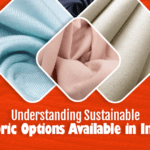Fabric Ranges Used in Apparel Manufacturing
Fabric Ranges Used in Apparel Manufacturing

The process of making garments requires careful consideration while choosing the fabric. Both the quality of the garment and how straightforward it is to construct a shell structure out of flat cloth depend on the fabric’s quality. The choice of fabric for a particular type of garment presents the producers with the greatest challenge. Understanding how fabric properties affect both the manufacturing process and the quality of the finished product is therefore essential. The selection of the appropriate fabric quality is an essential part of range construction.
As the leading Clothing Manufactures in India, we make customized products as per your specifications. This is a brief reference to help you understand the many materials we use, the various knits and weaves we can produce, as well as the textiles we can source for you.
100% ORGANIC COTTON
Pure organic cotton that is 100% natural is incredibly soft and pleasant. Strong, long-lasting, breathable, and hypoallergenic. Totally biodegradable makes it environmentally beneficial as well.
RECYCLED COTTON
The material of choice for environmentally aware manufacturers and retailers who support ethical fashion. This cloth is in high demand since businesses and consumers want to lessen their carbon footprints.
COTTON + POLYESTER + ELASTANE (SPANDEX) BLEND
While incorporating the practical properties of polyester and spandex, this cotton mix keeps the inherent goodness of cotton, such as breathability, sturdiness, and stability.
This tri-blend fabric is perfect for manufacturing sportswear or active wear because it is thin, breathable, strong, doesn’t wrinkle, and has good moisture-wicking properties.
COTTON + ELASTANE BLEND
This medium-weight blend requires little upkeep, maintains a happy lack of wrinkles, and has minimal pilling (with treatment). Elastane (Spandex), which is elastic, and cotton, which is durable and breathable, make this fabric perfect for manufacturing comfy loungewear, T-shirts, leggings, etc.
100% POLYESTER
Polyester, a cheap synthetic fabric that is always in style, has a lot going for it.
It doesn’t shrink, doesn’t wrinkle, keeps its shape, is long-lasting, is breathable, has strong water wicking capabilities, and is lightweight. It retains color beautifully as well.
POLYESTER + ELASTANE (SPANDEX) BLEND
Stretchy polyester fabric, sometimes referred to as “poly-spandex fabric,” is what makes up this combination. This fabric profile’s essential traits are lightness, breathability, durability, elasticity, moisture-repellent properties, softness, and others.
It is therefore perfect for comfort wear. It retains dye well as well.
MODAL
Currently, it is all the rage in the fashion sector. In addition to and beyond possessing all the attributes that make cotton so dear to us, it is a luxury fabric that feels silky (almost silk-like) on the skin. One variety of rayon is modal. It is a semi-synthetic plant-based textile created from beech-tree pulp.
It is a thin, incredibly breathable fabric with a little flexibility that drapes beautifully. For nightwear, innerwear, loungewear, and other items, it is the perfect fabric.
BAMBOO FIBER
In addition to other natural or synthetic fibers, bamboo pulp is used to create bamboo fiber, a type of rayon or viscose.
Even superior to cotton, bamboo fiber when combined with cotton produces a delightfully soft fabric. Additionally, its inherent anti-bacterial function is a bonus. The fabric gains stretch when treated with spandex. Ideal for comfort wear, nightwear, and innerwear, this bamboo cotton spandex blend.
As the leading apparel manufacturer and supplier in India, we are aware of how fabric characteristics impact the production process and how important final product quality is to our clients.
Recent Posts
-
 Understanding Sustainable Fabric Options Available in India
Understanding Sustainable Fabric Options Available in IndiaIn today's generation of heightened environmental consciousness and sustain...
Read more -
 The Comfort and Sustainability of Organic Cotton Sweatshirts
The Comfort and Sustainability of Organic Cotton SweatshirtsConcerning cozy and environmentally friendly apparel, eco-conscious consume...
Read more -
 How to Outsource Clothing Manufacturing: Exploring Pros and Cons for Small Fashion Businesses
How to Outsource Clothing Manufacturing: Exploring Pros and Cons for Small Fashion BusinessesWhen considering outsourcing clothing manufacturing, it's crucial to conduc...
Read more -
 T-Shirt Fabric Guide: What Is the Best T-Shirt Material to Wear?
T-Shirt Fabric Guide: What Is the Best T-Shirt Material to Wear?Choosing the right T-shirt fabric is crucial for comfort, style, and durabi...
Read more -
 What Is Slow Fashion & Why It's Important
What Is Slow Fashion & Why It's ImportantSlow fashion is a movement and approach to clothing and fashion that priori...
Read more


